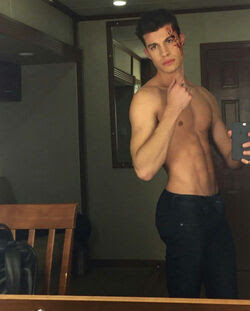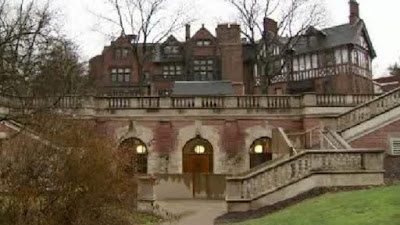When
Legend premiered in April 1986, I was living in West Hollywood, where everyone assumed that 23 year-old Tom Cruise was gay. But no one I knew saw it. Last night we watched the director's cut, and I found out why.
Scene 1: In his brightly-lit lair, the Lord of Darkness (Tim Curry with horns and 9-inch nails) gives plot exposition to his lackey, Blix, who speaks in rhyming couplets: He was about to make it so the sun wouldn't rise again. But then two unicorns appeared out of nowhere, so Blix has to get rid of them first. Also, the only thing that can stop his plan is inn-o-cence.
Scene 2: Inn-o-cence, aka Lili, is wandering slowly through a forest where bails of pollen, flower petals, and glitter are floating around, obscuring the camera and covering her face (how can she breathe?). There are several long close-up shots of her face as she grins idiotically. She is apparently very high.
Eventually she arrives at a peasant's house, where she can't seem to remember her lines.
Peasant woman: "Would you like a biscuit?"
Lili: Grins idiotically. "Ummm....what? Oh...um....I love coming here."
Peasant woman: "I'll get you a biscuit."
Scene 3: Back to the forest obscured by bails of pollen. Lili yells "Jack!" about a hundred times. Then Jack (Tom Cruise) appears, and she says "Jack!" another hundred times, while he grins idiotically. Lots of tight close ups of their faces covered with glittery stuff. Jack has bad teeth.
Then they stare at each other for a long, long time. Just when I think that he's feral and doesn't speak, Jack says that he'll finally take her to the place she's been begging to go to for months.
Scene 4: Stalked by Blix and his comic-relief lackeys, Jack and Lili go to the place, a nondescript piece of the pollen-drenched forest, and stare for a long, long time, while I wonder what the big deal is. Then two unicorns appear. "They'll only be here for a short time," Jack says. Then why was Lili begging to see them for months?
Lili starts to walk over to them. Jack stops her in a panic. "NO! You absolutely cannot go near a unicorn! It is absolutely forbidden! It is the worst sin of the pollen-drenched forest!"
But Lili ignores him and walks over, while Jack stares in horror. She touches a unicorn horn. They go rogue and run around her, neighing angrily, while she kneels and screams. (No one notices that Blix and his lackeys have used the confusion to blow a poison dart into one of the unicorns.)
Wait -- why were Blix and his lackeys stalking the girl? How did they know that she would lead them to the unicorns? Or does the Lord of Darkness want her, too? Her inn-o-cence is a threat, or something?
Scene 4: Later, Lili gets horny (she touched a unicorn horn and got horny -- get it?), and tries to seduce Jack, who is not sure if he's ready for sex. She sweetens the deal by throwing her ring into the lake and offering to marry him if he retrieves it. So he dives into the water and looks around.
At that moment, Blix and his lackeys approach the dead unicorn and sever its horn, which is the source of all magic in the world. Huh?
Suddenly the pollen-drenched forest turns into a snow-drenched forest, where snowflakes and for some reason bubbles obscure the camera and collect on people's faces. The lake is now iced over. Lili runs away, leaving Jack to drown. But he breaks through the ice and survives.
Scene 5: Lili runs to the peasant's house where she got the cookie. Everyone inside is frozen in place. She hides as Blix and his cronies come in to fool around with magic and do some plot exposition.
Then the Lord of Darkness shows up: they have successfully killed one unicorn, but a second is left, so the sun will rise again. Take care of it!
Meanwhile, Jack is approached by Honeythorn Gump (David Bennett), a pedophile's dream -- a little boy in a loincloth -- who is extremely high. He stares at Jack for a long time, grinning idiotically. Then he gets his eyes to bulge and yells "A human touched a unicorn! The worst sin in the pollen-drenched forest! Did you think you could perform such a sacrilege without consequences?"
Hey, it was Lili. Jack tried to stop her.Honeythorn says that he won't kill and eat Jack if he answers a riddle. Jack answers, and Honeythorn has a meltdown, screaming and kicking and rolling around on the ground. Wait -- you agreed to the riddle penalty.
Then, all nice, Honeythorn says "Let's gather the gang and try to fix this." His lackeys consist of two comic-relief dwarves and a ball of light that looks identical to the pollen floating around, but turns into a horny fairy when no one is looking.
That's enough scene-by-scene analysis. Next there's a lot of staring while grinning idiotically, some magical foes, and the Lord of Darkness (who suddenly has a father, the King of Darkness) deciding that he wants to marry Lili.
Jack rejects the horny fairy, who then refuses to rescue him from a dungeon (fortunately, she rescues her friends, who are in the same dungeon, so he can kind of tag along) He saves the day by reflecting sunlight into the castle, which blasts the Lord of Darkness off into space.
Back in the pollen-drenched forest, Jack says goodbye to Honeythorn and his lackeys, kisses Lili for a long time, makes plans to see her tomorrow, and then returns to Honeythorn and his lackies. Wait -- he said goodbye, as if he wouldn't see them again, and one five-minute-long kiss later, he's back? None of this makes any sense.
Beefcake: Nope. No one shows any skin except for the prepubscent David Bennet and Kiran Shah, who plays an elf saved from being baked in a pie. Obviously you take a guy's clothes off before cooking him.
Gay Characters: Maybe Honeythorn is into Jack. Jack is unwilling to have sex with Lili or the horny fairy, but that may be because he's a forest creature, and sex represents civilization or something.
Heterosexism: Jack and Lili are in love, of course. The Lord of Darkness turns out to be hetero-horny.
My Grade: Ugh. Tell your actors to lay off the weed, and cut back on the pollen!
 For over a century, people have been rejecting naturalistic literature to write heroic fantasy. In Britain, mostly about unlikely heroes who travel through magic-laden Medieval landscapes to fight ultimate evil (e.g., The Chronicles of Narnia, The Lord of the Rings). In America, mostly about heavily-muscled barbarians who travel through magic-laden ancient worlds to settle personal vendettas (e.g., Fafhrd and the Gray Mouser, Conan the Barbarian).
For over a century, people have been rejecting naturalistic literature to write heroic fantasy. In Britain, mostly about unlikely heroes who travel through magic-laden Medieval landscapes to fight ultimate evil (e.g., The Chronicles of Narnia, The Lord of the Rings). In America, mostly about heavily-muscled barbarians who travel through magic-laden ancient worlds to settle personal vendettas (e.g., Fafhrd and the Gray Mouser, Conan the Barbarian). 



























